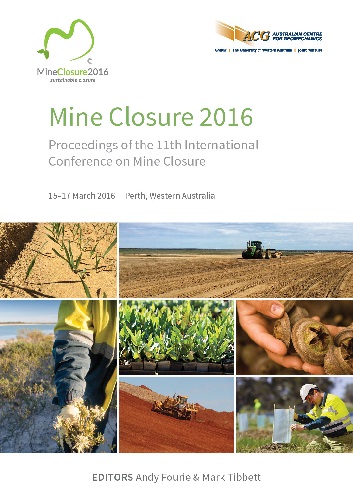Watercourse diversions relinquishment in Queensland – a risk-based approach to monitoring

|
Authors: Hallgath, A; Pearson, BA Paper is not available for download Contact Us |
DOI https://doi.org/10.36487/ACG_rep/1608_33_Hallgath
Cite As:
Hallgath, A & Pearson, BA 2016, 'Watercourse diversions relinquishment in Queensland – a risk-based approach to monitoring', in AB Fourie & M Tibbett (eds), Mine Closure 2016: Proceedings of the 11th International Conference on Mine Closure, Australian Centre for Geomechanics, Perth, pp. 453-465, https://doi.org/10.36487/ACG_rep/1608_33_Hallgath
Abstract:
Recent modifications to the model licence conditions for constructed watercourse diversions on operational mines in Queensland introduced an outcome-based approach to managing compliance of constructed diversions, as opposed to the previous prescriptive licence conditions. Watercourse diversion licences can now only be relinquished once they have proven a diversion has met the outcome-based conditions stipulated in the licence. Many watercourse diversions constructed as part of resource activities in Queensland have been designed with no or little consideration for geomorphic processes, natural watercourse hydraulics and/or the local vegetation landscape. For this reason, a large number of licenced watercourse diversions are in poor to moderate condition and will not be able to meet the outcome-based licenced conditions without significant rectification or modification works. Additionally, previous licence conditions required licence holders to undertake monitoring for individual diversions at varying frequencies (annual, biennial or five-yearly). However, the current Department of Natural Resources and Mines (DNRM) model licence conditions do not specify a monitoring frequency. This leaves licence holders in a difficult situation in which they have a relinquishment liability and no formal guidance from the administering authority regarding acceptable monitoring activities and frequencies. To assist a licence holder, we developed a risk-based method to inform watercourse diversion monitoring and evaluation programs, dictating monitoring frequencies and methodologies based on the diversion risk profile. The program also provided information about compliance liability against model licence conditions, developed management options for non-compliant watercourse diversions and prepared prioritised works programs to manage transition to compliance, particularly focussing on improving the likelihood of future relinquishment.
Keywords: diversion relinquishment, monitoring program, risk assessment
References:
ACARP (Australian Coal Association Research Program) 2000, Maintenance of Geomorphic Processes in Bowen Basin River Diversions - Stage 1, ACARP Project C8030, prepared by ID&A.
ACARP (Australian Coal Association Research Program) 2001, Monitoring and Evaluation Program for Bowen Basin River Diversions, ACARP Project C9068, prepared by ID&A.
ACARP (Australian Coal Association Research Program) 2002, Bowen Basin River Diversions: Design and Rehabilitation Criteria, ACARP Project C9068, prepared by Fisher Stewart.
ACARP (Australian Coal Association Research Program) 2014, Criteria for functioning river landscape units in mining and post mining landscapes, ACARP Project C20017, prepared by Alluvium Consulting.
DNRM (Department of Natural Resources and Mines) 2014, Guideline: Works that interfere with water in a watercourse – watercourse diversions, State of Queensland, Brisbane.
NRW (Department of Natural Resources and Water) 2006, Watercourse Diversions – Central Queensland Mining Industry, Queensland Government, Rockhampton, Queensland.
White, K, Lucas, R, Hardie, R, Merritt, J & Kirsch, B 2013, ‘Challenges and Opportunities for Constructed Stream Diversions in The Bowen Basin, Central Queensland’, Water in Mining Conference 2013, Brisbane.
© Copyright 2025, Australian Centre for Geomechanics (ACG), The University of Western Australia. All rights reserved.
View copyright/legal information
Please direct any queries or error reports to repository-acg@uwa.edu.au
View copyright/legal information
Please direct any queries or error reports to repository-acg@uwa.edu.au